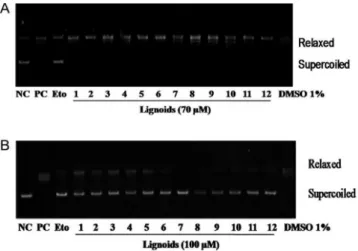Quim. Nova, Vol. 35, No. 11, 2226-2228, 2012
A
rti
g
o
*e-mail: creusioni@yahoo.com.br
#Artigo em homenagem ao Prof. Otto R. Gottlieb (31/8/1920-19/6/2011)
NEOLIGNANS FROM Licaria chrysophylla AND Licaria aurea WITH DNA TOPOISOMERASE II-α INHIBITORY ACTIVITY#
Amanda de Melo Bezerra, Antônio Cláudio da Silva Lins, Petrônio Filgueiras de Athayde-Filho, Marcelo Sobral da Silva e José Maria Barbosa-Filho
Laboratório de Tecnologia Farmacêutica, Universidade Federal da Paraíba, 58051-900 João Pessoa – PB, Brasil Celso Amorim Camara e Tania Maria Sarmento Silva
Departamento de Ciências Moleculares, Universidade Federal Rural de Pernambuco, Campus Dois Irmãos, 52171-900 Recife – PE, Brasil
Vanessa da Silva Luna e Creusioni Figueredo dos Santos*
Departamento de Biologia Molecular, Universidade Federal da Paraíba, 58051-900 João Pessoa – PB, Brasil
Recebido em 18/5/12; aceito em 28/9/12; publicado na web em 9/11/12
Seven natural neolignans isolated from Licaria chrysophylla and Licaria aurea along with five semisynthetic derivatives were tested for their inhibitory action on DNA-topoisomerase by relaxation assays on pBR322 plasmid DNA. All compounds tested showed strong inhibition at a concentration of 100 µM, while none showed activity between 5 and 70 µM. These results indicate that no obvious correlation can be derived between the structure of these compounds and their inhibitory effect on the DNA relaxation activity of topoisomerase II. This is the first report on DNA topoisomerase II inhibitors from Licaria chrysophylla and Licaria aurea leading to the identification of lignoids as topoisomerase II-α inhibitors.
Keywords: Licaria; lignoids; topoisomerase.
INTRODUCTION
DNA topoisomerase II is essential for cell division and pro-liferation, since it is required for the completion of mitosis by regulating DNA topology. Highly proliferating tumor cells were reported to express the enzyme at 25-300 times higher levels as compared to quiescent cells, suggesting topoisomerase II as a good target enzyme for novel anticancer drug discovery.1 Drug-induced
topoisomerase II-mediated double-strand breaks cause chromosome rearrangements and likely account for therapy-related cancers.2
The physiological and pharmacological relevance of prokaryotic and eukaryotic DNA topoisomerases is illustrated by the identi-fication of a large number of natural toxins and antibacterial and antitumor agents that target these enzymes.3 For instance, human
topoisomerase II is the target of several anticancer drugs, including etoposide, amsacrine, and doxorubicin.4 One of the major challenges
for successful chemotherapy in cancer, in general, is to overcome multidrug-resistance (MDR). Currently, many clinical anticancer drugs such as alkaloids (vincristine, cephalotaxine), anthracycline antibiotics (doxorubicin, daunorubicin), and lignans (etoposide, teniposide) may easily induce MDR.5,6
Lignoids are a family of natural products with a broad variety of biological and pharmacological activities, which have been found in a large number of species belonging to more than 60 families of vascular plants and isolated from different plant parts: roots and rhizomes, woody parts, stems, leaves, fruits and seeds, and in some cases from exudates and resins.7-14 These compounds are
biosyn-thesized by the coupling of two phenylpropanoid units (C6-C3). They constitute a complex family of skeletons and characteristic functionalizations which can be subdivided into different groups, such as lignans, neolignans, alolignans and heterolignoids, among others.15,16
The biological activities reported for lignan compounds include important antineoplastic and antiviral properties, as reported for podophyllotoxin and two of its semisynthetic derivatives, etoposide and teniposide. The latter derivatives are included in a wide variety of cancer chemotherapy protocols. Due to these biological activities, lignans, and especially neolignans, have been the subject of numerous studies aimed at developing better and safer anticancer drugs.17 In the
development of new inhibitors, natural products such as neolignans from Licaria chrysophylla and Licaria aurea can be a valuable source of inhibitors and may also serve as a suitable lead for the production of semisynthetic active agents. One benzofuranoid-type lignan (1) and six neolignans (2-7) were isolated from Licaria chrysophylla18-21
while the tetrahydrofuran-type neolignan grandisin (8) was isolated from Licaria aurea (Figure 1).21 Grandisin was evaluated for larvicidal
activity against the mosquito Aedes aegypti22 and for insect control
against Chrysomya megacephala.23
In the present study, seven natural (2-8) and five semisynthetic (1,9-12) lignoids were investigated for DNA topoisomerase II inhibitory activity. This is the first report on DNA topoisomerase II inhibitors from Licaria chrysophylla and Licaria aurea leading to the identification of lignans and neolignans as topoisomerase II inhibitors.
EXPERIMENTAL
Isolation of compounds and structural modifications
Seven of the compounds studied were natural products whose iso-lation has been reported elsewhere (2-7 from Licaria chrysophylla,18
and 8 from Licaria aurea21).
The isolation of 1 and chemical transformation of the compoun-ds (9-12) were done using previously described methocompoun-ds.20,21 For
example, compound 1 was obtained from the extract of bark from Licaria chrysophylla completely acetylated.20 Grandisin (8), the
Neolignans from Licaria chrysophylla and Licaria aurea with DNA topoisomerase II-α 2227 Vol. 35, No. 11
semisynthesis of a series of neolignans.21 Thus, acid treatment of 8
(HClO4, HOAc, reflux for 7 min) gave 9. Oxidation of 8 (KMnO4,
KOH, room temp for 30 min) gave 10. Reduction of 8 (Na, NH3) gave
11. This was transformed by hydrogenolysis into compound 12. These substances were deposited in the Bank of Standards of Natural and Synthetic Products of the Laboratório de Tecnologia Farmacêutica of the Universidade Federal da Paraíba, and for use in this work, they were repurified by thin-layer chromatography using the same system as described in the original papers.18-21
Human DNA-Topoisomerase II-α inhibitory activity
The conversion of supercoiled pBR322 plasmid DNA to the relaxed form by the enzyme topoisomerase II-α (topo II-α) was examined in the presence of the compounds.24 One unit of topo II-α
(USB Corporation, Cleveland, OH, USA) was incubated with 0.152
µg pBR322 DNA (human recombinant from E. coli, Invitrogen) with 0 (control), 5, 50, 70 and 100 µM concentrations of test compounds 1-12, in 10 µL of a mixture containing 10 mM Tris, pH 7.9, 50 mM NaCl, 50 mM KCl, 5 mM MgCl2, 0.1 mM EDTA, 15 µg mM BSA
and 1 mM ATP, 10 mM Na2HPO4 and 0.2 mM DTT for 40 min at
37 °C. The reaction was terminated by the addition of 1 µL of a stop solution consisting of 50% glycerol, 10% sodium dodecyl sulfate (SDS) and 25% bromophenol blue. Electrophoresis was carried out in 1% agarose gel equilibrated with TAE buffer (4.84 g L-1 Tris
base, pH 8.5, 1.14 g L-1 glacial acetic acid and 100 mL of 0.74 g L-1
EDTA) for 120 min at 40 V. Etoposide (Sigma-Aldrich) was used as the positive control. The gels were stained with ethidium bromide solution (5 g L-1) after electrophoresis for 30 min, washed with water
and photographed under UV light with a digital camera. The samples were diluted in 1% DMSO (99.9% ACS reagent) which was used as a reaction control.
Bezerra et al.
2228 Quim. Nova
RESULTS AND DISCUSSION
The conversion of supercoiled pBR322 plasmid DNA to relaxed DNA by topo II-α was examined in the presence of compounds 1-12. As shown in Figure 2B, all compounds showed strong inhibition of supercoiled DNA relaxation induced by topo II-α at a concentration of 100 µM, whereas when these 12 compounds were assayed at a concentration of 70 µM (Figure 2A) or lower (5-50 µM, data not shown), no inhibition was observed. These results indicate that no obvious correlation can be derived between the structure of these compounds and the inhibitory activity of DNA relaxation by DNA topoisomerase II. Compound 1 is a benzofuran-type lignin, and 2-7 are benzofuran-type neolignans. The inhibition of tubulin polymerization was the only previous report concerning potential antitumor activity of dihydrobenzofuran neolignans related to 3,4-di-O-methylcedrusin.22
The lignoids isolated from Licaria chrysophylla and Licaria aurea may be important leads for the development of new therapeutic agents based on structural modifications of these compounds.25
The exploration of the chemical diversity of the naturally oc-curring lignans and neolignans has resulted in the characterization of many interesting lead compounds in various therapeutic areas; it is thus reasonable to expect that many more leads have yet to be discovered and developed, mainly for antitumor drugs.25
This is the first report on DNA-topoisomerase II-α inhibitors from Licaria chrysophylla and Licaria aurea leading to the identification of lignans and neolignans as novel topo II-α inhibitors.
ACKNOWLEDGEMENTS
We thank CNPq/CAPES/FAPESQ-PRONEX, and PRONEM-FACEPE for financial support.
REFERENCES
1. Jeong-Youn, J.; Mejia, E. G.; Lila, M. A.; J. Agric. Food Chem. 2006, 54, 2083.
2. Azarova, A. M.; Lyu, Y. L.; Lin, C. -P.; Tsai, Y. -C.; Lau, J. Y. -N.; Wang, J. C.; Liu, L. F.; Proc. Natl. Acad. Sci. USA 2007, 104, 11014. 3. Nitiss, J. L.; Curr. Opin. Invest. Drugs 2002, 3, 1512.
4. Oppegard, L. M.; Ougolkov, A. V.; Luchini, D. N.; Schoon, R. A.; Goodell, J. R.; Kaur, H.; Billadeau, D. D.; Ferguson, D. M.; Hiasa, H.; Eur. J. Pharmacol. 2009, 60, 223.
5. Chen, H.; Bi, W.; Cao, B.; Yang, Z.; Chen, S.; Shang, H.; Yu, P.; Yang, J.; Eur. J. Pharmacol. 2010, 627, 69.
6. Silva, M. N.; Ferreira, V. F.; Souza, M. C. B. V.; Quim. Nova 2003, 26, 407.
7. Castro-Faria-Neto, H. C.; Bozza, P. T.; Cruz, H. N.; Silva, C. L. M.; Vio-lante, F. A.; Barbosa-Filho, J. M.; Thomas, G.; Martins, M. A.; Tibiriçá, E. V.; Noel, F.; Cordeiro, R. S. B.; Planta Med. 1995, 61, 101. 8. Castro, M. A.; Gordaliza, M.; Del Corral, J. M. M.; Feliciano, A. S.;
Phytochemistry 1996, 41, 995.
9. Serra, M. F.; Diaz, B. L.; Barreto, E. O.; Pereira, A. P. B.; Lima, M. C. R.; Barbosa-Filho, J. M.; Cordeiro, R. S. B.; Martins, M. A.; Silva, P. M. R.; Planta Med. 1997, 63, 207.
10. Verza, M.; Arakawa, N. S.; Lopes, N. P.; Kato, M. J.; Pupo, M. T.; Said, S.; Carvalho, I.; J. Braz. Chem. Soc. 2009, 20, 195.
11. Morais, S. K. R.; Teixeira, A. F.; Torres, Z. E. S.; Nunomura, S. M.; Yamashiro-Kanashiro, E. H.; Lindosof, J. A. L.; Yoshida, M.; J. Braz. Chem. Soc. 2009, 20, 1110.
12. Batista, A. N. L.; Batista Junior, J. M.; López, S. N.; Furlan, M.; Cava-lheiro, A. J.; Silva, D. H. S.; Bolzani, V. S.; Nunomura, S. M.; Yoshida, M.; Quim. Nova 2010, 33, 321.
13. Yamaguchi, L. F.; Freitas, G. C.; Yoshida, N. C.; Silva, R. A.; Gaia, A. M.; Silva, A. S.; Scotti, M. T.; Emerenciano, V. P.; Guimarães, E. F.; Floh, E. I. S.; Colombo, C. A.; Siqueira W. J.; Kato, M. J.; J. Braz. Chem. Soc. 2011, 22, 2371.
14. Aguiar, R. M.; Alves, C. Q.; David, J. M.; Rezende, L. C.; Lima, L. S.; David, J. P.; Queiróz, L. P.; Quim. Nova 2012, 35, 567.
15. Moss G. P.; Pure Appl. Chem. 2000, 72, 1493.
16. Barbosa-Filho, J. M. In Lignanas, neolignanas e seus análogos; Simões, C. M. O.; Schenkel, E. P.; Gosmann, G.; de Mello, J. C. P.; Mentz, L. A.; Petrovick, P. R.; eds.; Editora da UFSC: Florianópolis, 6a ed., 2007, cap. 22.
17. Gordaliza, M.; García, P. A.; Del Corral, J. M. M.; Castro, M. A.; Gómez-Zurita, M. A.; Toxicon 2004, 44, 441.
18. Lopes, M. N.; Silva, M. S.; Barbosa-Filho, J. M.; Ferreira, Z. S.; Yoshi-da, M.; Gottlieb, O. R.; Phytochemistry 1986, 25, 2609.
19. Barbosa-Filho, J. M.; Yoshida, M.; Gottlieb, O. R.; An. Acad. Bras. Cienc. 1987, 59, 335.
20. Silva, M. S.; Barbosa-Filho, J. M.; Yoshida, M.; Gottlieb, O. R.; Phyto-chemistry 1989, 28, 3477.
21. Barbosa-Filho, J. M.; Silva, M. S.; Yoshida, M.; Gottlieb, O. R.; Phyto-chemistry 1989, 28, 2209.
22. Cabral, M. M. O.; Alencar, J. A.; Guimarães, A. E.; Kato, M. J.; J. Am. Mosquito Contr. 2009, 25, 103.
23. Cabral, M. M. O.; Mendonça, P. M.; Gomes, C. M. S.; Barbosa-Filho, J. M.; Queiroz, M. M. C.; Mello, R. P.; Fitoterapia 2007, 78, 20. 24. Esteves-Souza, A.; Figueiredo, D. V.; Esteves, A.; Camara, C. A; Vargas,
M. D.; Pinto, A. C; Echevarria, A.; Braz. J. Med. Biol. Res. 2007, 40, 1399.
25. Apers, S.; Vlietinck, A.; Pieters, L.; Phytochem. Rev. 2003, 2, 201.
Figure 2. A. All lanes contain 0.152 µg DNA (pBR322) and 1.0 U topo II-α,

